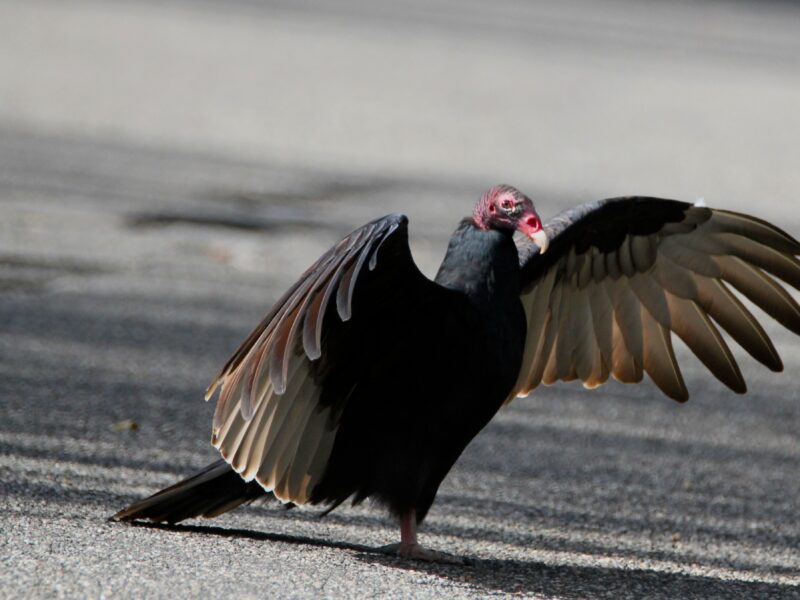
Vulture: It’s not a pleasant word — it shares its roots with “vulgar” — but apparently is fitting for a very big bird that is black, gathers on the sides of roads and survives on carrion.
Terry Sullivan, who resides in Sag Harbor and photographs birds, the bigger the better, knows more about the local turkey vulture population than anyone I can think of. There are three turkey vulture species in the Americas. The black vulture, more of a southern bird, satisfies its palate in two ways: It eats already dead animals, but if they are scarce, it acts like a predatory species and catches its dinner.
They are not very pretty up close, but they are graceful gliders and, like some herring gulls that glide past my windows all day long, can stay in the air circling for hours without exercising a single wingbeat as long as there are upwelling thermals present.
Apparently, this is the year of the vulture on the South Fork. True, there are ospreys, a few bald eagles and fish crows around, but, according to Terry, never have there been so many vultures. Terry regularly sees as many as 20 sailing over Sag Harbor at one time.
If one follows a flock around, as Terry frequently does, you will find that they have preferred venues — locally, Havens Beach, Otter Pond and the western edge of Sag Harbor Village, in the same way that the fish crows like to hang around the Sag Harbor Post Office. Just why they keep showing up at the same places here, day after day, he has yet to discover.
Jean Held is another vulture observer who writes down every vulture encounter she has. She, too, wonders why so many vultures are around now, when they were very scarce just a few years ago. She agrees with Terry’s prognostication that they are increasing locally, dramatically. But, she wonders why — what could they be eating?
About four years ago, Terry confronted a vulture with a squirrel at its feet on a road. Terry took a picture and, while he was doing so, the vulture raised its wings as if to threaten Terry.
That one squirrel might have been enough for one vulture meal. Did the word get out, Terry wonders, and the present-day large number of vultures came by hoping for more squirrels and other roadkills? But where are they? They have yet to materialize.
Turkey vultures are monogamous — they mate for life. The female is just as ugly as the male, so one can understand why they stick with each other. They also tend to use the same nest each year, the way eagles and ospreys do.
Their necks are largely unfeathered, so as to gum up their plumage as little as possible. Because they specialize in eating carrion, no matter how careful they are, they still are quite mussy. But while they are mussy eaters, they do the countryside a great service by cleaning up all of the dead bodies on the country’s roads.
Their eyes are fairly sharp, but their biggest attribute is their acute sense of smell. They use the excellent olfaction ability to locate many of their meals. No other members of the vulture group are so blessed. Their wings are almost 6 feet from tip to tip, great for sailing on air currents over roads.
Where did the name “turkey” come from? Think back: The turkey species had another name when white men first came upon it in southwestern North America. The name “turkey” originated in southwestern Europe and was transported to eastern North America as the big bird became more and more common. Turkey vultures have partially bare necks, and the heads, except for the big beak, superficially resemble those of turkeys, thus the confusion.
While we still confuse turkey vultures with turkeys, the former will never replace the turkeys on our platters and dinner plates come Thanksgiving.
Before I leave you today, dear reader, here’s a note that’s dear to my heart: Water — it makes up 60 percent of our entire adult body and 73 percent of the heart (and brain). Our Long Island aquifers are a result of the advance and retreat of three glaciations over the millennia.
So, whatever you flush down your toilet, put on your lawns and golf courses (aside from the many industrial spills all over this island), it always comes back to bite us.
Next weekend, April 14 to 16, is a veritable three-day “film festival” on our aquifers, which are the sole source of our drinking water — no upstate reservoirs with snow/rain runoff from the Catskills or Adirondack for us. It’s vital that we protect our water resources.
Informed and informing, the “Hamptons Doc Festival” will kick off its celebration of “Earth Day” at the Southampton Arts Center with “All In for the Aquifer.”